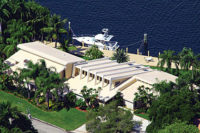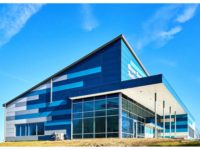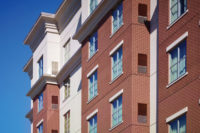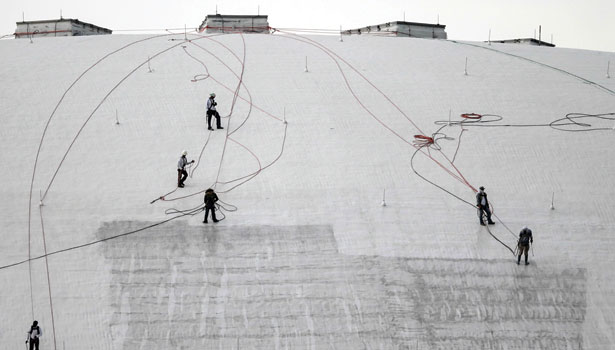Coating Gives Superdome a Bright New Roof

A New Orleans landmark, the iconic Mercedes-Benz Superdome has a new high-performance gleaming white roof with a guaranteed 20 year-long service life. Photo courtesy of Nationwide Photographers

The re-coating job started with a thorough pressure washing of the entire 9.6-acre roof with United Cleaning Concentrate to remove dirt and buildup of biological growth. This 2-week cleaning helped prep the surface much better for the subsequent coating applications. Photo courtesy of David Grunfeld, NOLA.com/The Times-Picayune

Workers sprayed on two Kymax® topcoats at a rate of 6 wet mils. This highly weatherable coating (formulated with Kynar Aquatec® PVDF latex) provides resistance to dirt and biological growth buildup as well as cool roof properties. Photo courtesy of Nationwide Photographers

The beautiful new bright-white, highly reflective dome offers significant advantages in lowering the roof temperature of the Superdome by reflecting heat from the sun. Photo courtesy of Nationwide Photographers




The Mercedes-Benz Superdome in New Orleans is immense in both its size and its impact on the American sports and entertainment scene. The iconic stadium—the largest fixed dome structure in the world—is situated on 52 acres of land in the city’s central business district and home to the NFL’s Saints, as well as two major college football bowl games: the Sugar Bowl and New Orleans Bowl. It has hosted seven Super Bowls, four BCS National Championship games, and five Final Four basketball tournaments. The stadium also holds the world record for the largest crowd (87,500) for an indoor concert.
The Landmark Dome
The Superdome’s massive white domed roof serves as a New Orleans landmark and represents one of the most challenging aspects of maintaining the appearance and performance of the overall structure. In 2006, following the devastation caused by Hurricane Katrina and as part of the 5-year, $336 million upgrade project, Trahan Architects and roofing contractor Brazos Urethane collaborated on what the New Orleans Times-Picayune called, “the largest roof job in American history.”
More than 10,000 pieces of galvanized metal decking were mounted on the roof and then coated with a 2.5-inch layer of polyurethane foam. It took nearly half a million gallons of foam to complete the entire roof. Workers then applied five layers of urethane coating, resulting in a membrane about as thick as a nickel. Less than two months after the roof was finished, the Superdome hosted its first event after Hurricane Katrina, a Monday Night Football game between the Saints and the Atlanta Falcons.
Ahead of the Game
Because the white domed roof is such an important landmark in the “Big Easy,” its aesthetic appearance is of paramount importance to both SMG New Orleans, the Superdome’s management group, and the city itself. New Orleans’ challenging, hot and humid environment, combined with the Superdome’s downtown urban location, meant the roof needed a coating that could resist buildup of dirt and biological growth.
In 2013, with the expiration on the roof’s 10-year warranty approaching, some blistering and ponds appearing on the roof, SMG New Orleans initiated the recoating project.
The process started with extensive research on various types of coatings by lead architect Brad McWhirter of Trahan Architects.
Based on that research, eight different coating products from various manufacturers were chosen to test on the roof of the Superdome for 6-10 months. In August 2013, samples were coated, placed on the roof, and then evaluated for their performance in color retention, cleanliness, and ability to resist biological growth.
According to McWhirter, the inspection made it clear that the Kymax coating “did what Quest Construction Products said it would do: resist biological growth and dirt buildup, and retain its reflective value and color. It proved it could offer the specific durability and aesthetic performance characteristics we wanted.”
Kymax is a thin-build elastomeric coating that provides long-term color stability, resistance to dirt buildup, and protection against severe weather conditions. It is based on Kynar Aquatec® latex, a water-based PVDF fluoropolymer technology developed by Arkema Inc. that provides similar durability and performance as Kynar 500® PVDF resin-based coatings.
However, unlike factory-applied Kynar 500 resin-based coatings, coatings based on Kynar Aquatec latex cure at ambient temperatures, meaning they can be field applied to a variety of substrates, including metal, PVC, SPF, and concrete, and as a finish coat over acrylic basecoats. Another benefit of the coating is the potential energy savings created by its ability to resist biological growth and other external factors that reduce the reflectivity of traditional roofing materials.
McWhirter said the Kymax coating also offered “an extremely compelling selling point”: a 20-year complete roof system warranty from Quest Construction Products, covering not just the coating itself but the foam membrane underneath.
The Project Kicks Off
To prepare for the job ahead, the Brazos Urethane team set up a mini-warehouse on the seventh floor of the Superdome. From there, they could stage for every step of the roof coating process and pump materials outside to the worksite.
First, United Cleaning Concentrate was used to power wash the roof. The next step was applying one layer of Kymax “solar gray” basecoat. Before its application, Tom Keller, project manager for Brazos Urethane, said the team first divided the roof into 16 equal pie sections, which were then further divided into 50-foot increments, working from bottom to top. This way, he said, the team knew exactly how much footage was in each section, which helped ensure a consistent application rate of 16 wet mils for the Kymax basecoat.
After the basecoat was applied, low areas, ponds and blisters were repaired with polyurethane foam and Roof Mate™ Buttergrade, a water-based, high-tensile strength elastomeric sealant. Working again in 16 pie sections, the workers then applied two white Kymax topcoat layers in a similar fashion but at a much lower rate of 6 wet mils each.
“It was basically a mist coating,” said Keller. “Our applicators are used to spraying on a much thicker layer of coating and so I told them to approach their work more like painting a car than applying a roof coating. We used smaller tips and had no issues with applying the topcoats at all.”
The Kymax coatings were mixed inside of the Superdome at the mini-warehouse, then pumped with low-pressure drum pumps out onto a platform that the team built outside in the gutter system. They were then mixed again before application via airless spray pumps at a rate of 4,000 psi.
Keller said the quality control on the dome application was “second to none,” adding that representatives from Quest Construction Products were on site several times to oversee the process. Keller’s crew, as well as the quality control team, took small slit samples of application areas that were then evaluated in the lab to verify coating thickness. However, the product’s ease of mixing and spraying meant that the team was “right on the money” in its application rate.
Finishing Touches
The final step in the process—coating the Mercedes-Benz logo at the center of the roof and the lettering along the north and south sides of the dome—presented its own unique set of challenges. The basecoat and topcoats were applied up to the old logo. Then, Keller said, using brushes and rollers, his team hand-applied specialized Kymax coatings in “Mercedes-Benz Black” for the logo and lettering. This innovative coating contains IR reflective pigments, which help reduce blistering by lowering the surface temperature upwards of 30 percent.
“It was a slow and tedious process, but it really paid off,” Keller said. “The first time I saw the roof on TV at night, it was so clear and bright. I called my boss and said, ‘Did you see? You can actually read the words.’” McWhirter agrees, saying the roof now appears lit from within. “The dome is whiter than it has ever been, even at night,” he said. “You can see the logo because the roof is brighter. There are no lights on the roof but yet the dome is so reflective that it always appears to be glowing.”
Meeting the Weather Challenge
The Superdome roof project should have taken six weeks to complete, but ended up taking almost twice as long because of weather issues. Pop-up thunderstorms presented a particular danger because of lightning, and heavy rains could ruin the water-based systems during application. Crews relied on weather apps and their own experience to guide them.
“Being on that dome so much, and being able to see the lay of the land, you can see storms approaching and know which ones were coming our way,” Keller said. “On windy days, we knew the ‘calm side’ where we could still apply the coating.”
Safety was a primary focus, and the job was completed with no injuries or time lost due to safety issues. All new ropes, harnesses, and rope grabs were purchased and specifically fitted for the job, and daily safety meetings ensured all concerns were addressed.
Keller said that despite the delays that caused the process to stretch into the Saints’ preseason and regular season, Superdome management and staff were “extremely courteous” and cooperated with his team to get the project finished as soon as possible and with minimal disruption.
The 20-Year Certification
Upon completion of the work, the roof was evaluated by two independent inspection companies who verified the quality of the high-performance Kymax roof coating. More than 700 measurements were taken during this extensive inspection process. This included testing of additional slit samples according to ASTM standards for total solar reflectance and color tolerances. On November 15, 2014, Quest Construction Products issued the comprehensive 20-year warranty covering all labor and materials for the new roof.
The new roof is one of the largest cool roofs in the country and is expected to save on energy costs for the Superdome. Additionally, because the new coating has excellent dirt and biological growth resistance, maintenance costs will be reduced. “The old coating needed to be power washed every year to maintain its white appearance,” McWhirter said. “Now the goal was to eliminate the need for washing. The Kymax topcoat is almost self-cleaning. When it rains, it appears to wash itself.” Keller agrees, saying the Superdome roof is brighter than ever.
“This was my first experience using the Kymax coating, and with a 20-year lifespan, I have to say it is an amazing product,” he added. With its brilliant white roof guaranteed to last for the next 20 years, the Superdome is once again ready for the national spotlight.
“When I drive by that roof, I am proud to tell people, ‘See that? We did that,’” Keller said. “That roof will always be special to me. But I don’t ever intend to be on it again. With the Kymax top coat and the 20-year warranty, I won’t have to be.”
Looking for a reprint of this article?
From high-res PDFs to custom plaques, order your copy today!









